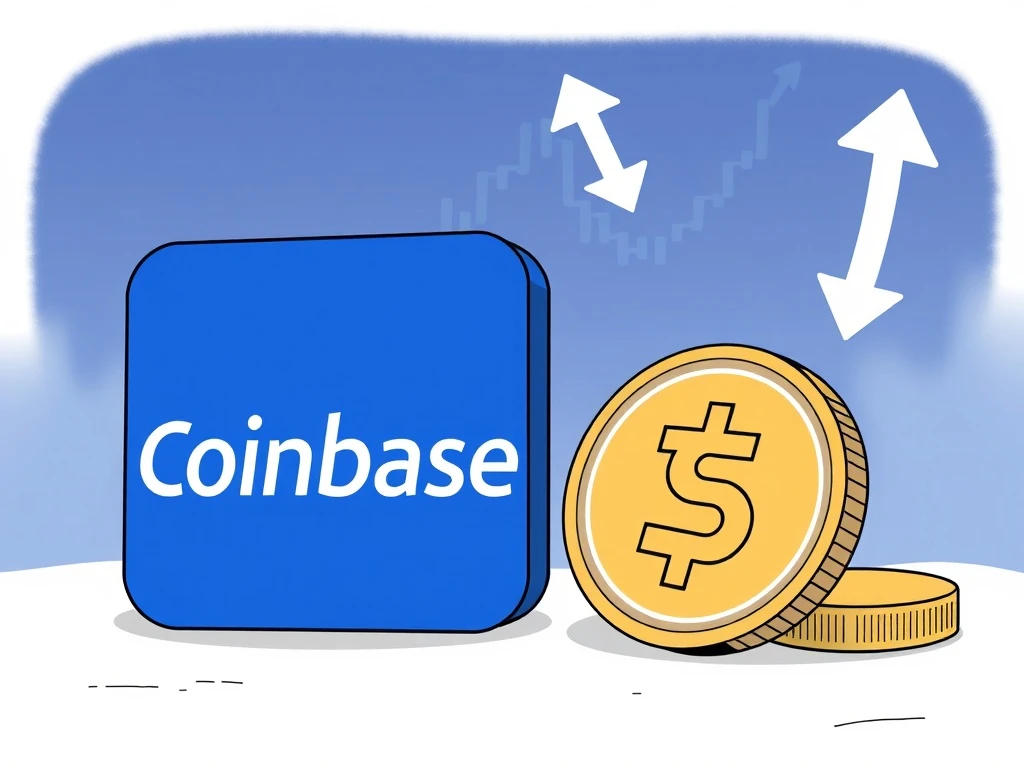Coinbase USDC Fee: Urgent Changes to Stablecoin Swaps

The cryptocurrency landscape continually evolves. Therefore, staying informed about major exchange policy shifts is crucial. Recently, Coinbase announced a significant change affecting stablecoin users. This move introduces a 0.1% Coinbase USDC fee for high-volume conversions. Specifically, it targets USDC to US dollar swaps exceeding $5 million. This decision marks a pivotal moment for users engaged in large-scale USDC to USD conversion activities.
Understanding the New Coinbase USDC Fee Structure
Coinbase, a leading crypto exchange, will soon implement a new fee structure. Starting August 13, a 0.1% fee will apply to net conversions of USDC to US dollars. This charge affects amounts above $5 million within a 30-day rolling period. The net conversion calculates by deducting USDC purchases from sales. Previously, Coinbase offered fee-free conversions up to $40 million. Fees only kicked in at 0.05% for amounts between $40 million and $100 million. They scaled up to a maximum of 0.2% for conversions over $200 million. Consequently, this new policy significantly lowers the fee-free threshold. Users should carefully review their conversion strategies. This adjustment impacts high-volume traders most directly. It signals a shift in how Coinbase manages its stablecoin services.
Coinbase Earnings Miss and Revenue Adjustments
This new fee arrives after Coinbase faced financial challenges. The company reported its second-quarter results last week. These figures missed analyst expectations for both revenue and earnings. As a result, Coinbase’s shares experienced a notable decline. This marks the second consecutive quarter the company has missed projections. Its Q1 revenue also came in lower than anticipated. However, stablecoin-related revenue did show growth. It rose 12% year-on-year, reaching $332 million. Despite this segment’s strength, overall Coinbase earnings miss signals a need for broader revenue adjustments. The introduction of new stablecoin fees appears to be one such measure. The exchange seeks new avenues for income amid fluctuating market conditions. Therefore, this fee could help stabilize its financial performance.
Coinbase’s ‘Experiment’ with Stablecoin Fees
Coinbase describes this new fee as an ‘experiment.’ Will McComb, Coinbase’s senior product manager for stablecoins, clarified this stance. He stated the exchange aims to understand how fees impact USDC off-ramping. McComb noted that some competitors charge higher fees for fiat conversions. He emphasized Coinbase’s commitment to being the best place for stablecoin use. However, this explanation has not quelled all concerns. Bankless co-founder Ryan Sean Adams expressed apprehension. He shared his worry on X, asking, “What if this dropped to $10k. Feels like bank fees again.” This sentiment reflects broader user anxiety. Many fear that such ‘experiments’ could lead to more restrictive policies. Ultimately, Coinbase must balance revenue generation with user satisfaction. The outcome of this ‘experiment’ will likely influence future fee structures. It also highlights the ongoing debate around crypto exchange fees and their fairness.
Addressing Arbitrage: The Role of Tether and USDC
Several commentators speculate on the fee’s underlying purpose. One prominent theory involves arbitrage. Crypto influencer Jordan Fish, known as “Cobie,” suggested the fee aims to curb a specific arbitrage strategy. Users were reportedly converting Tether (USDT) to USDC. They then off-ramped the USDC into US dollars for free. Tether charges a fee for its own conversions, typically 0.1% or $1,000, with a minimum redemption of $100,000. This made swapping USDT to USDC a cheaper exit route. Cobie explained this practice reduces USDC supply while maintaining USDT supply. Coinbase CEO Brian Armstrong publicly agreed with Cobie’s assessment. This agreement lends weight to the arbitrage theory. The new Coinbase USDC fee might therefore protect USDC’s market dynamics. Data from DefiLlama shows significant growth for both stablecoins. USDT’s market capitalization rose 20% this year. USDC’s market capitalization, however, increased by 47% during the same period. This growth underscores the importance of managing stablecoin flows efficiently.
Cost Offloading and Market Implications for Crypto Exchange Fees
Bloomberg ETF analyst James Seyffart offered another perspective. He suggested Coinbase likely incurs costs in facilitating USDC creation and redemption. “This feels similar to a create/redeem fees for an ETF,” Seyffart remarked. He believes Coinbase is now passing these costs onto users. “My guess is they’re offloading that cost … and then some,” he added. This perspective aligns with the idea of operational efficiency. Large-scale stablecoin conversions require significant infrastructure and liquidity management. By introducing this crypto exchange fees, Coinbase can recover these expenses. The move reflects a broader trend in the industry. Exchanges are seeking sustainable business models. They must navigate volatile markets and intense competition. Ultimately, the new fee represents a strategic adjustment. It aims to shore up Coinbase’s financial health. Furthermore, it could influence how other exchanges structure their stablecoin services. This ongoing evolution in fee models remains a key area for market observers.
The Broader Impact of Coinbase’s Fee Adjustment
The new Coinbase USDC fee has wide-ranging implications. It directly affects institutional investors and high-volume traders. These entities often rely on large stablecoin conversions for liquidity management. The fee could lead them to explore alternative off-ramping solutions. Moreover, it highlights the increasing scrutiny on stablecoin fees across the industry. As stablecoins gain wider adoption, their underlying cost structures become more critical. This decision by Coinbase underscores the ongoing challenges faced by major crypto platforms. They must balance user expectations with financial sustainability. Ultimately, this fee adjustment could reshape stablecoin conversion practices on Coinbase. It also serves as a reminder that even seemingly minor policy changes can have significant market repercussions. The crypto community will closely watch the impact of this new fee. Its success or failure could set precedents for future exchange policies.








